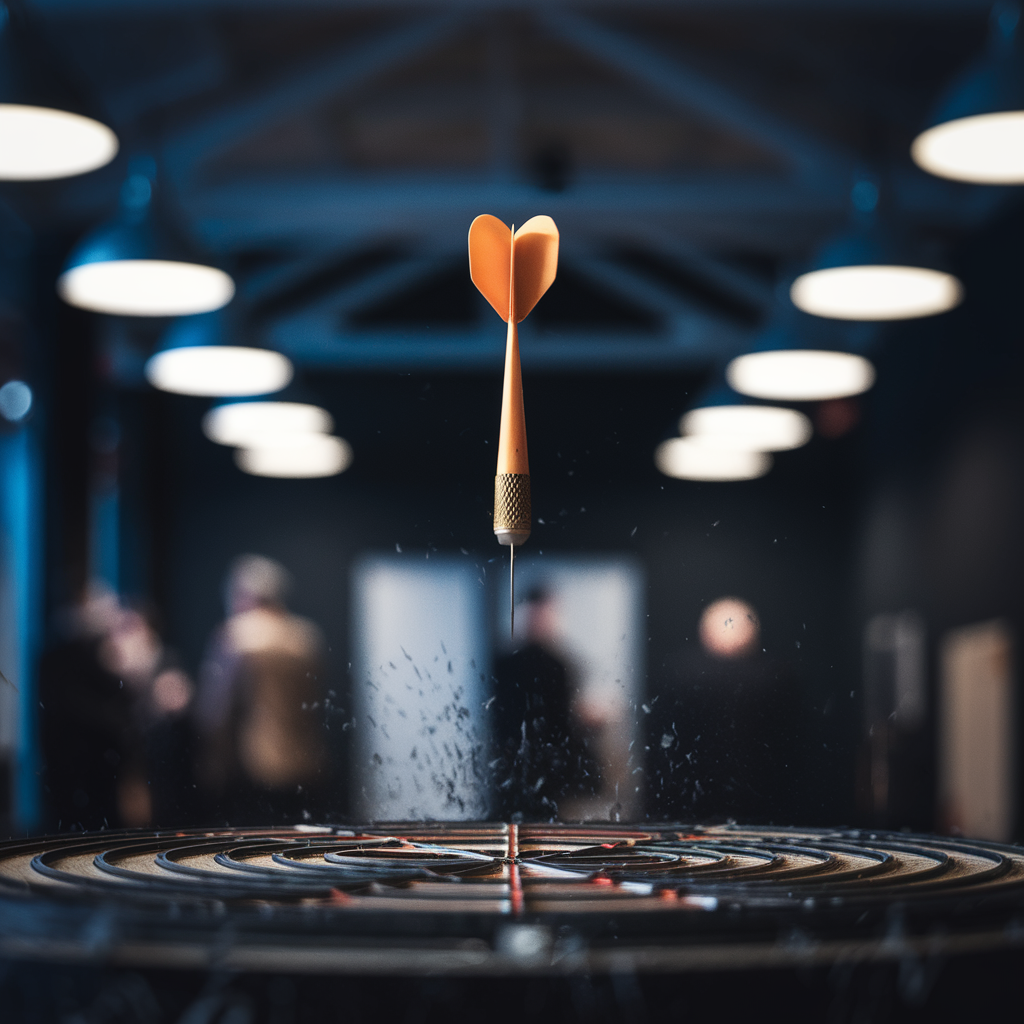Darts: A Comprehensive Guide to the Game and Its Mastery
 A dartboard with darts hitting the bullseye under bright lighting, showcasing the precision and skill involved in darts.
A dartboard with darts hitting the bullseye under bright lighting, showcasing the precision and skill involved in darts.
Darts is a captivating game of precision, strategy, and focus that has stood the test of time. From local pubs and social gatherings to prestigious international competitions, darts remains a popular pastime enjoyed by millions. Its simplicity allows beginners to pick it up quickly, while the game’s strategic depth ensures a challenge for even the most seasoned professionals. This guide explores the rich history of darts, the rules, strategies, essential equipment, and tips for mastering this beloved game.
The History of Darts
The origins of darts can be traced back to medieval England, where soldiers would throw shortened arrows at the bottoms of wine barrels or tree trunks. Over time, the game evolved into a refined indoor sport, complete with standardized equipment and rules.
Key milestones in the history of darts include:
The Emergence of Dartboards
By the late 19th century, segmented dartboards replaced makeshift targets. The classic dartboard design, known as the “clock” board, was popularized in the early 20th century.
Standardization of Rules
In 1924, the National Darts Association was formed in the United Kingdom, establishing standardized rules that shaped modern darts.
Professionalization
The sport gained international recognition through the establishment of organizations such as the Professional Darts Corporation (PDC) and the British Darts Organisation (BDO). These organizations host world-class tournaments, attracting players and fans globally.
Thus, what started as a pub game has grown into a celebrated global sport with professional leagues and televised championships.
Basic Rules of Darts
The game of darts has several variations, but the most common format is 501, which is played in professional settings. In this format, players aim to reduce their score from 501 to exactly zero by hitting specific segments on the dartboard.
Basic rules for playing 501 darts:
1. Starting the Game
Each player throws a dart to determine who goes first. The dart that lands closest to the bullseye wins the opening throw.
2. Scoring
- The dartboard is divided into numbered sections (1–20), with single, double, and triple scoring zones.
- The outer bullseye scores 25 points, and the inner bullseye scores 50 points.
- Players subtract points from 501 until exactly zero is reached.
3. Doubling Out
To win, the final dart must land in a double segment or the inner bullseye. Over-scoring or missing the double resets the player’s score for that round.
4. Turns and Rounds
Players take turns throwing three darts each round, carefully strategizing their shots to maximize scoring efficiency.
By following these rules, players can enjoy a structured and competitive game of darts.
Equipment Needed to Play Darts
To play darts, having the right equipment is essential. Proper gear ensures accuracy, consistency, and a smooth playing experience.
Essential equipment includes:
Dartboard
The standard dartboard, known as the “Bristle Board,” features 20 numbered segments with double and triple scoring zones. For professional games, the regulation size is 18 inches in diameter.
Darts
A dart consists of four main components:
- The Tip: Steel-tipped darts are used on bristle boards, while soft-tipped darts are suitable for electronic boards.
- The Barrel: The main body of the dart, available in various weights and materials.
- The Shaft: Connects the barrel to the flight and affects dart balance.
- The Flight: Stabilizes the dart during flight, ensuring accuracy.
Throw Line (Oche)
The throwing line, or “oche,” is marked 7 feet 9.25 inches away from the dartboard for standard play.
Lighting and Surroundings
Good lighting ensures clear visibility of the dartboard, and protective backboards or surrounds prevent damage from stray darts.
With the right equipment, players can enhance their performance and enjoyment of the game.
Techniques for Throwing Darts
Throwing darts may appear simple, but mastering the technique requires practice and precision. The following techniques can help players improve their accuracy:
1. Proper Grip
Hold the dart with a firm yet relaxed grip using three fingers: the thumb, index finger, and middle finger. Avoid gripping too tightly, as it can affect control.
2. Stance
Adopt a stable and balanced stance. Position your lead foot slightly forward, keeping your weight evenly distributed for consistency.
3. Aiming
Focus on your target, aligning the dart with the intended segment on the board. Use your dominant eye to aim, maintaining steady concentration.
4. Smooth Throwing Motion
Execute a smooth throwing motion with a controlled follow-through. Avoid jerking your arm or snapping your wrist, as this can disrupt accuracy.
5. Consistent Practice
Repetition is key to mastering the perfect throw. Practicing regularly helps refine muscle memory and improve overall precision.
By applying these techniques, players can develop a consistent and accurate throwing style.
Strategies for Winning at Darts
To succeed in darts, players must combine precision with strategy. Effective strategies include:
Target the High-Value Segments
Aim for the triple 20 segment early in the game to score maximum points efficiently. This strategy reduces the total needed to reach zero.
Plan Your Finishing Shot
As you approach the end of the game, plan your shots to ensure you finish with a double. Skilled players memorize common “checkouts” for smooth finishes.
Minimize Risk
Play conservatively if necessary to avoid busting your score. Focus on hitting single or double segments instead of risky shots.
Analyze Your Opponent
Pay attention to your opponent’s strategy and performance. Adjust your gameplay accordingly to maintain a competitive edge.
Maintain Focus
Concentration is critical in darts. Eliminate distractions and maintain a steady rhythm to ensure consistent throws.
By incorporating these strategies, players can increase their chances of success in competitive matches.
Popular Darts Variations
While 501 is the most common format, darts offers several popular variations that add variety and excitement to the game.
Cricket
Players aim to “close” numbers 15–20 and the bullseye by hitting them three times. Points are scored when closed numbers are hit while the opponent’s remain open.
301
Similar to 501, but players start with 301 points and work their way to zero. This shorter format is ideal for casual play.
Around the Clock
Players hit numbers in sequential order from 1 to 20, finishing with the bullseye. This variation emphasizes accuracy and consistency.
Killer
In this game, players aim to hit a specific number to become a “killer.” Killers eliminate opponents by hitting their designated numbers.
These variations provide opportunities for diverse gameplay, keeping da-rts enjoyable and challenging.
Professional Darts Competitions
Darts has grown into a professional sport, with major tournaments attracting global audiences. The most prominent competitions include:
PDC World Darts Championship
Held annually, this tournament is the pinnacle of professional da-rts, featuring the world’s top players.
BDO World Darts Championship
Organized by the British Da-rts Organisation, this competition has a long history and remains a key event in the sport.
Premier League Darts
A prestigious league where elite players compete over several weeks, showcasing their skills across various venues.
World Matchplay
This knockout-style tournament is celebrated for its high stakes and electrifying matches.
These events elevate da-rts from a casual game to a global phenomenon, inspiring players to pursue excellence.
Health Benefits of Playing Darts
Playing darts offers several mental and physical benefits, making it an excellent activity for people of all ages:
Improved Focus and Concentration
The game sharpens mental focus as players aim for precise targets and strategize their shots.
Enhanced Hand-Eye Coordination
Throwing darts improves coordination between vision and motor skills, benefiting overall dexterity.
Stress Relief
Engaging in da-rts provides relaxation and stress relief, particularly in social settings.
Social Interaction
Da-rts encourages socialization, fostering friendships and team camaraderie in both casual and competitive environments.
By promoting these benefits, darts remains an enjoyable and healthful activity.
Conclusion
The game of da-rts is a perfect blend of skill, strategy, and precision, offering endless enjoyment for players of all skill levels. From its humble beginnings to its status as a professional sport, darts has remained a timeless and accessible game. By understanding the rules, mastering the techniques, and applying effective strategies, anyone can excel at da-rts, whether playing for fun or competing at the highest level.











